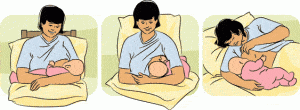By the time your baby is born, your breasts would be structurally and functionally mature to breast feed your baby. Within half to one hour of delivery,as soon as you have recovered from the stress of labor, you should put your baby straight to the breast after cleaning the breast properly. Even when baby has been born by cesarean section,you should start breast feeding as soon as you have recovered from the effects of anesthesia. You should have the confidence , and if the motivation is strong,every baby born by cesarean section can be breast fed without any difficulty.
The initial watery yellow milk which is secreted during first 1-2 days(colostrum) must never be denied to the baby. It is rich in protein and protective factors. The baby should be fed on a semi demand schedule and most babies would like to take feeds every 2-3 hours. They need to be fed day and night during first 4-6 weeks of life.
The baby should be given exclusive breast feeding as it provides unique benefits both to the baby and to his mother.
- Breast milk is a complete food and it provides all the nutrients a baby needs during first 6 months of life. Breast milk is more easily digestible. Breast fed babies do not need any supplements of vitamins and iron during first 6 months of life.
- Breast milk contains a number of anti-infective substances and antibodies, which protects the baby against development of diarrhea, respiratory illness (cough and cold) and other infections (especially ear infection). Breast feeding has been shown to reduce the risk of death due to diarrhea by 14 times, acute respiratory infections by 4 times and other infections by 3 times.
- Breast fed babies are less likely to suffer from allergic disorders like asthma and eczema.
- Breast feeding provides immunological benefits t the baby for the life time. Breast fed babies have been shown to develop better protective response to various vaccines compared to bottle fed babies.
- Breast feeding provides emotional security and promoted close bonding between mother and her baby. Breast feeding provides maternal warmth, physical closeness and comfort to the baby.
- Breast fed babies are smarter and have been shown to have higher intelligent quotient (IQ). High concentrations of two key long chain fatty acid and lactose promotes brain growth.
- Breast fed babies are less likely to suffer from diabetes mellitus, obesity, high blood pressure, heart attacks and certain cancers during adult life.
- There is no risk of adulteration, dilution, contamination and infection of breast milk.
Read : Preparation for Breast Feeding
Benefits to the mother:
- During breast feeding there is a release of oxytocin to eject the milk. Oxytocin helps to contract the uterus so that there is reduced risk of bleeding after delivery.
- Breast feeding delays ovulation and onset of menstruation which provides natural means to ensure spacing of children. (Nevertheless, mother who is breast feeding must seek proper contraceptive advice).
- Breast feeding is convenient and less time consuming. Breast milk is readily available all the time at the desired temperature. There is no need to buy feeding bottles and artificial milk and no time is wasted for sterilization of bottles and preparation of feeds.
- There is a misconception among several women that breast feeding spoils the figures. on the contrary, breast feeding helps to maintain and regain the per-pregnancy body weight earlier because energy stores laid down during pregnancy are consumed faster during lactation.
- Mother who breast feed their babies have a reduced risk of development of breast and ovarian cancer.
How to ensure good lactation?
During pregnancy, breasts enlarge in size under the influence of sex hormones and become functionally mature to secret milk when baby is born. During lactation mother should take plenty of liquids, extra milk and nutritious diet to meet the nutritional cost of lactation. Intake of Daliya , khichidi , oatmeal, spinach, almonds , yogurt , increase the intake of cumin seed also help in good lactation.
Ensuring close skin to skin contact and eye contact with your baby enhances lactation. Early and frequent feedings are associated with milk production. Milk production is related to the concept of demand and supply; more vigorously and frequently the baby sucks, more milk is produced. When a mother is relaxed and confident she is likely to produce more milk. Early introduction of supplementary bottle feeds may lead to poor lactation because baby finds it easier to feed from a bottle and refuses to make efforts to breast feed.
The art and techniques of Breast feeding
Breast feeding is natural and instinctive and most mother are able to breast feed without any difficulties. There are many ways to breast feed and you will develop your own style to suit your baby. There are certain steps that will help you to breast feed ease and comfort.
- You may sit comfortably on a chair, on the bed or floor (squat) to feed your baby. It is important that you must feel comfortable and your back must be supported. You must also feed by lying down in bed if baby was
 born by cesarean section or you are unwell.
born by cesarean section or you are unwell.
- Hold your baby in your arm so that his head and neck rests in the bend of your elbow, the back along your hand. If you are feeding baby on the right breast, your right arm should be used to cradle the baby.
- Bring the baby’s entire body towards you so that his tummy touches your tummy. The baby’s head and neck must be comfortably supported on the hollow of your elbow.
- Raise the baby to the level of your breast so that the baby’s mouth can easily reach the nipple and areola. You can place a pillow below your arm or raise your thigh to lift the baby (if you are sitting cross-legged on the floor). To bring the baby snugly close to you, at times you may need to tuck your baby’s arm away so that it does not come in the
 way. You may use your free hand to hold your breast or to fondle your baby once he is well attached for feeding.
way. You may use your free hand to hold your breast or to fondle your baby once he is well attached for feeding.
- When your baby’s lips or cheek touches your breast, the baby will automatically open his mouth and root towards nipple. The baby should grasp the nipple and part of areola of the breast in his mouth. This is called attachment to the breast.
